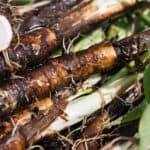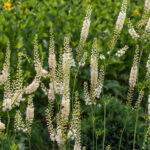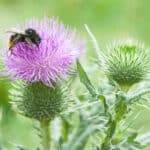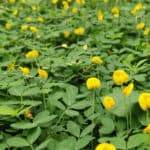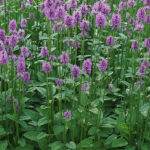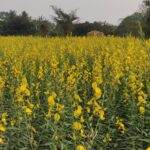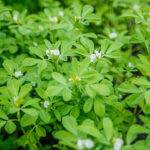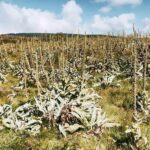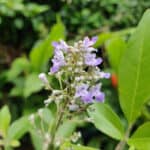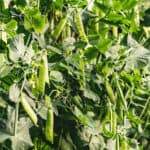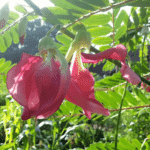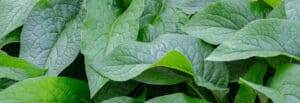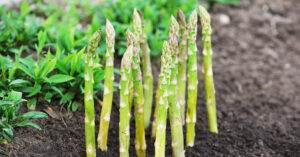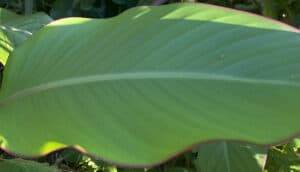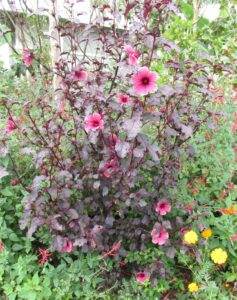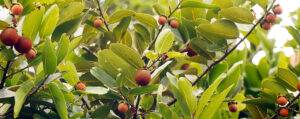With its iconic three-leaf shape and attractive globe flowers, Clover is an easily recognizable plant growing wildly in meadows, fields, pastures, and along roadsides. Many of us in our childhoods quickly got to know this plant as a safe one to explore, pick, and chew on, trying to find that little burst of sweetness at the end of the flower blossoms. In fact, Clover is so widespread and familiar (and low to the ground) that it can easily be overlooked for its great contributions to agriculture, herbal medicine, and the balancing of wild ecosystems and domesticated plantings alike.
Clover: Three Leaves Growing in Meadows
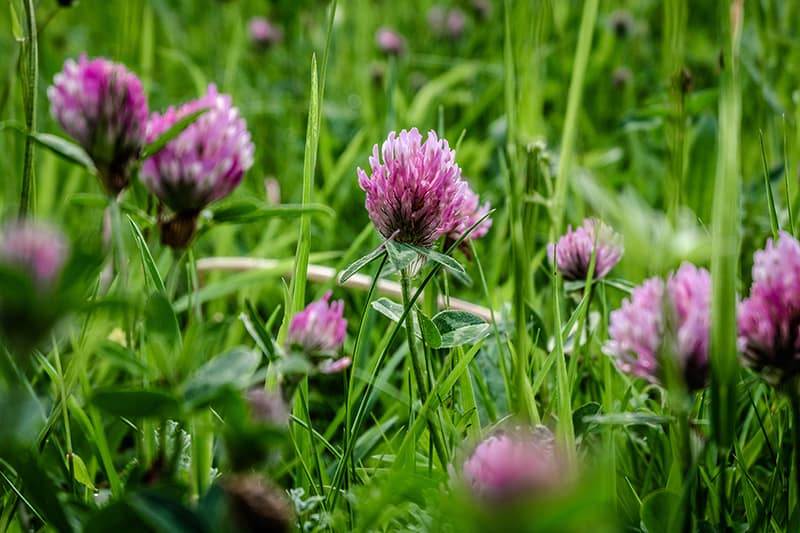
Red clover’s genus name, Trifolium pratense, translates to “three leaves growing in meadows,” and begins to paint the picture of this plant. Clover’s compound palmate leaves grow in fairly flat and open trios. These bright green leaves are elliptic, about ½” to 1 ½” long, and feature a light green – white “V” shaped pattern across their middle. Lower on the plant, leaves are attached to the stems with long stalks; towards the top, they are nearly stalkless. Red clover grows 1-2 feet tall and branches, densely at its base and thinning out only slightly towards the top, where each slightly-hairy stem supports several flowers.
Red clover’s most recognizable feature reveals it as a bit of a misnomer. Its sweet-smelling flowers are not really red, but more of a purple pink. Each 1” round/ovoid flower head consists of densely packed tubular flowers. Look closely, and you’ll see that each of these tubes is actually shaped just like a pea blossom, confirming Clover’s place in the legume family (Fabaceae). Clover’s bloom period is a long one (late Spring through late October in many areas), and is especially attractive to bumble bees, whose long tongues are able to reach the nectar within. Many species of butterflies are also drawn to the flowers.
Described as a biennial or self-seeding perennial, an individual clover plant may only live three to five years. But a well-tended patch encouraged to self-sow its own seed, can be maintained for many years.
The Widespread Reach and Appeal of Clover
Clover is native to Central Europe, West Asia, and Northwest Africa. Its three-leaf shape inspired much symbolism in Medieval Europe, where Clover came to be associated with the Holy Trinity and an emblem of Salvation. Clover spread to England in the mid-1600’s, and was later brought to north-eastern North America by British colonists. It was grown extensively as a nutrient-rich forage crop for grazing livestock, including cattle, horses, and sheep. Today, it is widely naturalized.
Many of Clover’s medicinal properties were uncovered by Native Americans, who used the plant for many purposes: to soothe irritated skin, treat whooping cough, purify the blood, and remedy sore or irritated eyes. They also realized its nutritional value, and incorporated Clover as a food staple in their diets.
Modern herbalists and wildcrafters continue to tout Clover’s medicinal abilities. Much attention is given to its use in soothing the symptoms of Menopause, including hot flashes, vaginal dryness, fatigue, and insomnia. It continues to be used to remedy respiratory issues, such as whooping cough and bronchitis.
Clover is also valued for its use as a nitrogen-fixing cover crop in regenerative farming and organic agriculture. Clover and other legumes form symbiotic relationships with Rhizobium bacteria in the soil, through which nitrogen in the atmosphere is converted into a form available to plants. This greatly increases the fertility of the soil, the growth potential of a field, and the nutritional value of the plants or fodder grown in the area.
In an homage to its widespread use and appeal throughout the countryside, Red Clover was popular enough to be voted the State Flower of Vermont in 1894.
Propagation
Site Selection (Zones 3-9)
Clover prefers full sun, but will tolerate partial shade with fewer blooms. Moist or dry conditions are okay, with a greater emphasis on adequate drainage. Clover seems to do best in slightly acidic soils, but can grow in a wide range of the pH scale (5.5-7.5). Increasingly, Clover is being used as ground cover in fruit orchards, on the edges or in between rows or clusters of trees.
Don’t underestimate this friendly plant’s ability to self-seed and spread. In some areas, Clover is treated as an invasive species. Choose your site wisely, and see the management techniques listed below.
Growing From Seed (recommended)
In January-April or August-November, scatter the tiny Clover seeds about 2” apart at a depth of ¼ – ½”. You can also broadcast the seeds and lightly dust them with soil – or spread a very thin layer of straw over your seeding to keep moisture in for germination. Pre-soaking seed in warm water for 12 hours greatly increases germination but also makes the seeds a bit harder to handle.
In a cover-cropping or green manure situation, clover can be frost-sown into a stand of annual grains such as wheat or rye. The freezing and thawing of the ground in Winter cause the ground to heave and works the small seeds into the soil for later Spring growth.
Growth & Care

Maintenance – Not much required!
Once it takes root, Red Clover is a very hearty and competitive plant that requires little care. If anything, its growth sometimes needs to be kept in check. Even though Clover doesn’t have a long lifespan, it is an avid self-seeder and features very long and aggressive branching taproot systems. Therefore, it’s quite challenging to remove Clover once it is well established, particularly without the aid of tillage.
To keep Clover from spreading, you can lightly till in the plants in late Summer. This brings all of that great green manure into the soil, and will increase fertility. Alternatively, a no-till approach would be to put an opaque tarp over the area for a month or two to smother the growth and feed the micro-organisms below. You can also cut the seed heads from the plants in late Summer to mid Fall. Certainly, having animals graze your Clover plot is a great way to manage the area.
In many cases, the spreading of Clover is not a problem at all. Imagine converting your grass lawn to a beautiful Clover patch!
Pests
For better and for worse, Clover is a great draw for many animals. This includes rabbits and deer. Consider growing Red clover as a “trap crop” away from where you grow food to keep these pests outside of the garden gates.
Insect pests include the clover root curculio and clover root borer, who damage the roots of the plants and seem to mostly be an issue in large-scale agricultural plantings.
Disease
Powdery mildew is the main disease that affects Red clover. It covers the leaves with a pale gray powdery fungus. While this is rarely a fatal problem in the garden, you can select certain cultivars that are more resistant to powdery mildew.
Harvest
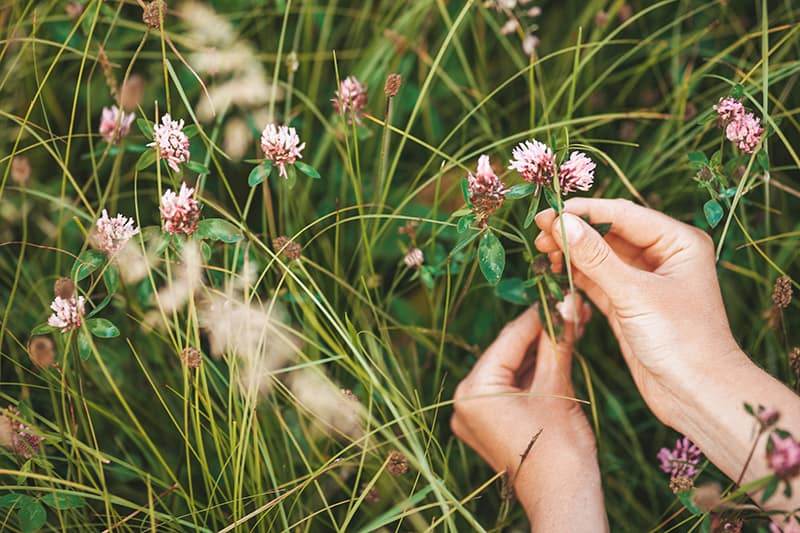
Leaves
Young tender leaves, harvested before the plant begins flowering, can be used fresh in salads. Slightly older clover leaves can be cooked in soups or stews.
Flowers
Harvest Red Clover flowers in the morning when they are still dewy and looking fresh – one to two weeks after they first appear. They lose much of their nutritional and medicinal value once the flowers begin to brown. Flowers can be used immediately, eaten (imagine the sweet grassy flavor of a sugar snap pea) or made into tea – or they can be passively dried on a rack or in a basket in a well-ventilated area. Flowers should be fully dried in one to two weeks.
Use
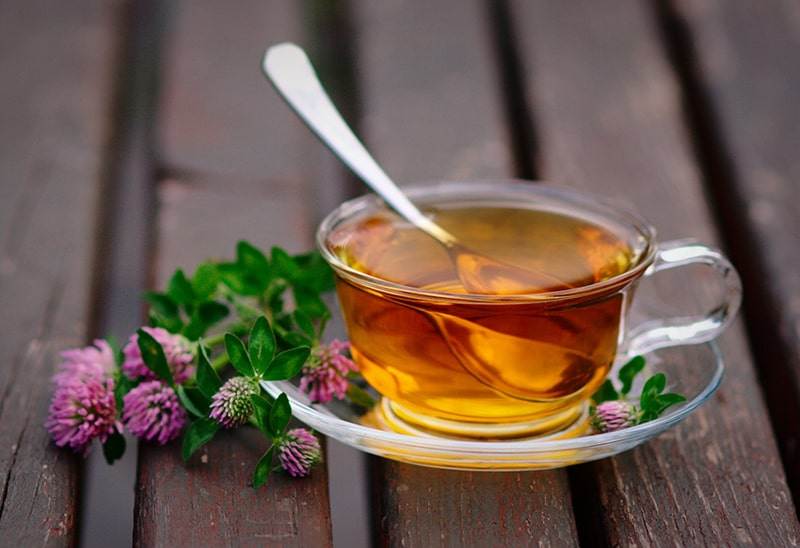
* Red Clover is known to contain chemicals called phytoestrogens, similar to the hormone estrogen. This contributes to some of its benefits in balancing out the effects of Menopause. But people who have, or are at risk for, hormone-sensitive Cancers, should avoid the use of Red Clover. As always, the practice of herbal medicine should always be done in collaboration with a health professional. *
Clover’s flowering tops are both slightly sweet and deeply nutritive, which makes them an excellent choice for a gently restoring tea. Steep 1 Tablespoon of dried flowers in 1 Cup of boiling water for 10-15 minutes, and enjoy.
Tinctured Red clover is commonly used to reduce inflammation in the lungs, and to treat respiratory issues.
Closing Thoughts
Clover is at once an unassuming and deeply powerful plant. A childhood friend, a Medieval symbol, and a nutritional powerhouse for soils, humans, and animals. Easy to grow and maintain, it has great use in farm, orchard, and home settings (Let’s replace those grass lawns!). Even for those of us familiar with it, Clover deserves a second look.

